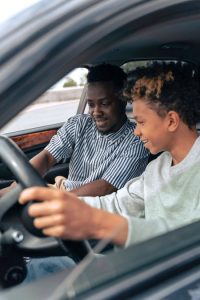FAMILY SAFETY: How to Unlock 24/7 Safety Excellence – By Mackenzie Wilson
As the daughter of someone who works in health and safety, I can attest first-hand to the value of bringing safety home to your family. Although, there aren’t too many people that really need convincing. Most people will freely admit that they care more about their family’s safety than their own. They certainly care more about it than their coworkers’. But knowing that keeping our family safe is important doesn’t mean that it’s always easy to do so. We say ‘be careful’ with good intentions, however, that phrase does little to actually keep anyone safe. Over 95% of unintentional fatalities happen away from work. The majority are at home, as well as the motorway or highway. Furthermore, nearly twice as many children die accidentally each year compared to adults. So, what really works? What can we do we keep our families safe?
Obviously, different approaches are needed depending on who you’re trying to help. Small children will need to be taught differently than your spouse or a teenager. But regardless, the first step is the same. No matter who you’re wanting to help, you need to begin by building credibility within yourself. If you simply go back home and tell your spouse that they need to do things differently, I can assure you it won’t go over well. In general, people don’t like to be told that they’re not safe enough. So, if you first begin by demonstrating the habits and behaviours you’re hoping for them to adopt as well, you’re much more likely for it to catch on. If you tell your kids not to run with scissors, but they see you being irresponsible with a kitchen knife, they will notice. For safety to truly become a value in your home, you need to show that it is a value for you. We tend to call this ‘walking the talk.’
There are 10 million disabling injuries to children and youth in the USA every year, and approximately 8-10 thousand unintentional fatalities. So let’s start with small children. Really, this is the best time to introduce them to safety, because they have no resistance to the topic yet. The challenge mainly lies in getting them to become aware of the hazards around them. Let me to share a story to illustrate…

The lurking danger around us
Many years ago, my family and I were staying at a hotel in Vancouver. I was quite young, only 6 or so, but this day remains vivid in my head. My sister and I used to love the little shampoo and conditioners that hotels would have; we would use them as props for our dolls. I was standing on the hotel room balcony with my dad. My younger sister who was about 4 at the time came running out to show us the mini shampoo and conditioner from the bathroom. She was so excited, and asked my dad if she could keep them. He told her that she could, and if there was more in the second bathroom then I could have those ones. So, my sister turned and ran back into the room. However, in doing so she tripped on the runner for the sliding door of the balcony, fell, and hit her head on the 90-degree corner of the iron coffee table. It cut clean to the bone, just above her eyebrow. Had her head have been turned slightly and she hit it on the temple, she easily could have died. She was taken to the hospital, my dad held her head as she was given 7 internal and 6 internal stiches, and as the story goes, he sat there wondering what he could do to prevent this from happening again. He knew that telling her to ‘be careful’ next time wasn’t going to help. As he thought about it, he realized that my sister just wasn’t aware of the hazard the iron coffee table posed, or how rushing can cause her to not see things that she could trip on. He wondered how to effectively teach us kids about the danger around us.
He ended up making a game for my siblings and I to play, where we would point out all the hard, sharp, hot, and slippery things in the area every time we went somewhere new. We did it enough that we would do it even without our parents present. I can recall a time where my sister and I were going to practice some of the things we learned in gymnastics at home, and I stopped and checked to make sure there was nothing hard or sharp for us to get hurt on. When my sister began preschool, she did the same thing, going around the classroom and identifying the hazards. The teacher was amazed. She asked my dad to write out what she was doing on the whiteboard, but he realized that he could do better than that. He ended up creating Boo Boo Bandits, a film series of 4 episodes, designed to teach children about the main things that can get them hurt. The first episode introduces the Boo Boo Bandits (the bad guys): Ms. Hard, Mr. Sharp, Ms. Hot, and Mr. Slippery. It also educates kids on the mental and physical states that make them more susceptible to the bad guys, like being tired (Fourty Winks), angry (Maddy), going too fast (PDQ), and not thinking (Mr. Complacency). He didn’t stop there though, because although only 3% in total of unintentional fatalities involve drowning, a much higher percentage of them are children, the same goes with poisoning. Therefore, the next three episodes of Boo Boo Bandits introduce more villains, such as ‘Breathless’ and the ‘Toxic Twins’, to teach kids about drowning, suffocation, and poisoning.

Educating the Boo Boo Bandits
At every expo booth I have worked at, at conferences around the world, it is always the kid’s colouring books that are the first to go. Before anyone picks up the numerous other books, brochures, key tags or pens that we have, they go straight to the stuff for the kids. It’s not because they don’t care about the other materials—they get to those later—but they see the colouring books for what they are: a rare resource for educating children about safety in a fun and engaging way. The latter part is really the key. There aren’t that many fun, interactive ways to teach kids about safety. This is why I am so passionate about Boo Boo Bandits.
As we get older, the type of hazards and danger we are exposed to changes. Especially when we begin learning how to drive as teenagers. As your kids learn how to drive, believe me when I say that they are learning from you and your habits. If you want them to develop good driving habits, you must model that behaviour. Every time you forget to shoulder check, or you pick up your phone while they’re in the car with you, they are learning that those behaviours are okay. The same thing goes with driving while tired. Most of the time, a driver will ask their co-pilot to talk to them to keep them awake. But if the co-pilot falls asleep, it’s rare that the driver will wake them up. I have seen my dad ask hundreds of people how many of them wake their co-pilot up (although he has asked this question to thousands), and not too surprisingly, there are never any hands in the air. But beyond modeling good habits, there are other tools you can use to help keep your kids safe on the road. You can check in with them before they go out in the car and ask them ‘if you were likely to get into an accident, where would it be?’ By Anticipating Error, we can help fight complacency by priming our subconscious to be thinking about danger in the moments where we will most likely encounter it. The same is true for sports. Before a football game, or dance recital, if you get your children to think about where and when they are most likely to get hurt, they will be less likely to become complacent in those moments.
Educating your Spouse
Now, not being married myself, I cannot speak from personal experience about the challenges of educating your spouse or partner on safety. I can however share a few anecdotes from my father. An important thing to understand is that if your spouse or partner wanted to change their behaviour as it relates to safety they already would have. Like when you’re driving, if you want to driver faster you put your foot on the gas. If you want to drive slower you put your foot on the break. People are already driving at a speed they think is safe enough for them. So, if you say something to your spouse about them needing to do something differently, it will feel like you’re saying, ‘my safety judgement is better than yours.’ In all likelihood, this will only get you into a ‘who’s safer than who’ argument, which is guaranteed to get you nowhere in terms of a positive direction (quite the opposite, in fact). So as I mentioned, the first thing you should do is show that you are taking the concepts to heart personally. You must work on yourself and your habits before you begin to teach others. Another helpful approach is to alert your partner about the example they set for your kids. Even if they are not particularly concerned about improving their own safety, reminding them that your children are watching and learning habits all the time is a good motivator to help change behaviour.
For companies, showing that they value not just the employee’s safety but also the safety of their family can do incredible things in terms of improving safety culture. I have attended a few family days, where kids and spouses come to the worksite to learn, play games, and spend time together. Some places even offer driving training for teenagers. In all these places, the company’s value for safety was apparent. This is what happens when you are encouraged to bring safety home to your family: it becomes an embedded value in each member of the organization. Teaching safety related concepts to others also helps employees understand them on a deeper level, making it beneficial for everyone.The majority of unintentional fatalities happen away from work. So if you want employees to take safety at work seriously, start with where the real risk is – and where their heart is.

For more information
Location: https://g.page/SafeStart-International?share
Tel : +91 44 42321920
Mail: [email protected] /
Web: http://asia.safestart.com

